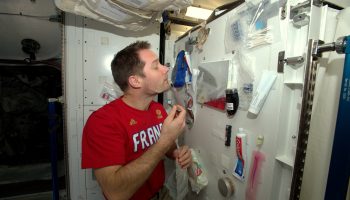(English) Welcome to Outer Space
- access_time 20/07/2017
- chat_bubble_outline 14 comments
DATES CLÉS
- Jeudi 17 novembre 2016 :
Lancement : 21:20:13 CET
Séparation du Soyouz MS : 21:28:58 CET
- Samedi 19 novembre :
Amarrage : 23:02:06 CET
- Dimanche 20 novembre :
Ouverture de l'écoutille : 01:15 CET
- Vendredi 13 janvier 2017 :
Première sortie extravéhiculaire
- Vendredi 24 mars :
Seconde sortie extravéhiculaire
- Vendredi 2 juin :
Fermeture de l'écoutille : 09h31 CET
Atterrissage : 16h09 CET





Discussion: 14 comments
This is absolutely fantastic!
Many thanks!
Merci de partager avec nous cette merveilleuse aventure de l’espace
Thank You!
It is fantastic .. thanks veery very much
This reportage does it exist in french linguage ???
How to contact Thomas Pesquet to have some news about it ????
BRGDS
CHris DIVERS
Is it possible to use this with Google Cardboard?
Mr Pesquet, une question me frotte l’esprit : pour quelle raison êtes-vous rentrer le 153 ème jour de l’année ( initialement, vous deviez rentré le 15 mai ) et pourquoi votre collègue américaine Peggy Whitson rentrera le 3 septembre afin de cumuler précisément un total de 666 jours passés dans l’Espace ( initialement, elle devait rentrer en juin ) ? Cordialement et amicalement.
Salut Thomas!
Pourquoi lorsque la fusee Soyouz se met en orbite autour de la Terre, et donc commence a provoquer le phenomene d impesanteur dans son interieur, la capsule se secoue, vibre?
On croyait qu il se produit une explosion.
Si le phenomene d impesanteur de nos jours semble etre presque banal, on en comprend la cause, on le voit a travers les videos que vous partagez, son histoire reste floue, on ne sait pas bien comment ou qui a pense que ce phenomene pouvait exister dans
le passe, quels scientifiques on etablit les premiers sa possible existence?
merci pour votre explication!
Marcel
Bonjour M. Pesquet ! Félicitations en tout. J’ai suivi avec admiration votre intervention avec Juan Gomez ce 10/10/2017 sur RFI. Une autre question Please: Quand vs étiez dans l’espace, observant tout ce qui est autour de vous, contemplant la terre et autres, vs vs êtes dit Le Créateur de tout ceci existe ou c’est fait naturellement suite à un Big Bang. Ceux qui sont croyants priaient-ils en invocant Dieu ou vs pensiez que vs étiez les maîtres de l’univers à travers vos technologies ?
Cher Thomas,
Je m’appele Rashed Al Busaeedi d’origine Emirati et je suis un élève en première série Scientifique au Lycée Louis Massignon a Abu Dhabi. Cette année, je dois rendre mon TPE (Travail Personnel Encadré, consiste à traiter un sujet comportant de la science et de la physique en groupe) en début de février 2019, qui comptera pour la note du Baccalauréat. Nous avons donc former un groupe de trois élèves et nous devrons passer un oral afin de le présenter. Notre sujet est le suivant: « Pourquoi met-on les astronautes dans un fauteuil roulant après leurs atterrissage sur Terre? ».
Afin de donner plus de valeur et de dynamiser notre projet, nous souhaitons que vous participez avec nous en oral si c’est possible. Ça serait un grand honneur de recevoir une petite vidéo (entre deux ou trois minutes) expliquant vos sensations, pensées, expérience …après avoir atterri sur terre.
Dans cette vidéo, nous espérons que vous nous mentionnerez (Rashed, Mohammed et Oussama) afin que les jurys soivent persuadés, convaincus et impressionnés.
Votre participation nous aidera beaucoup à créer un projet hors du commun et ajoutera de la créativité.
Je vous remercie d’avance pour votre précieuse aide.
Cordialement ,
Rashed Al Busaeedi.
Hello Thomas Pesquet
Please could you confirm if you you will be attending the annual open day in Amsterdam in October 2019.
Thank you
Angela Ollington-Browne
Bonjour monsieur Pesquet,
L EPSM de Caen organise une journée festive sur le thème de l espace le jeudi 18 juin 2020,Les patients les usagers enfants et adultes ainsi que le personnel seraient enchantés de vous recevoir pour nous raconter votre expérience de voyage dans l espace. Vous trouverez ci-joint notre mail pour nous contacter valérie.bonneau @epsm-caen.fr.Vous remerciant par avance pour votre réponse. Bien cordialement V. Bonneau.
Coucou Thomas et a ton équipe je te quif comme tu es,grand merci pour ce que fait et on t’aime
Thomas pesquet j’adore t’es photos